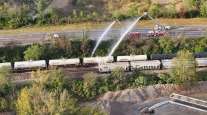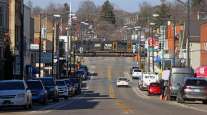cleveland.com
Ohio Weighs Two-Year, Multibillion-Dollar Transportation Budget

[Stay on top of transportation news: Get TTNews in your inbox.]
COLUMBUS, Ohio — The cost of materials to build and expand roads and bridges increased by 11.4% last year, Ohio Department of Transportation Director Jack Marchbanks told lawmakers Feb. 7 during a hearing in which he unveiled Gov. Mike DeWine’s transportation budget recommendations.
“This is a high number considering the long stretch of low inflation we benefited from in the recent years,” he said.
During most years, such high inflation would have forced ODOT managers to hit the brakes on construction. But ODOT made no cuts to projects, thanks to the 4-year-old increase to the state’s gas and diesel taxes, as well as new federal transportation dollars in the bipartisan Infrastructure Investment and Jobs Act, he said.
Marchbanks presented details about DeWine’s budget proposal, which calls for spending $3.7 billion in state and federal money in each of the next two fiscal years, which start July 1. Each year’s spending is about 25% more than the current year’s budget, thanks to funding from the bipartisan infrastructure law passed by Congress and the federal funding dedicated to the Brent Spence Bridge Corridor Project. That project, being completed by ODOT and the Kentucky Transportation Cabinet, aims to improve the double-decker bridge over the Ohio River carrying traffic on interstates 71 and 75 that was already over capacity when it opened in 1963.
While the vast majority of the transportation budget covers roads and bridges, it also includes smaller pots of funding for public transit, electric vehicle infrastructure and drone development, among others. Over the next two years, ODOT wants to spend $2.3 billion on roads and $717 million on bridges.

Host Seth Clevenger speaks with autonomous vehicle pioneer Don Burnette about the pros and cons of driverless cars and trucks. Hear the program above and at RoadSigns.TTNews.com.
Third of a three-part series on autonomous vehicles. Hear Part I here, and Part II here.
The Legislature is expected to pass the two-year transportation budget separate from the two-year general government operations budget. The transportation budget usually passes first, in April. Lawmakers are expected to consider and make changes to DeWine’s proposals.
Marchbanks highlighted several aspects of the budget.
Public Transit
While most of ODOT’s funding goes toward road projects, Marchbanks said ODOT will offer local governments $211 million to pay for transit: $103 million in the first year and $108 million in the second year. The money would be distributed to local transit agencies across Ohio.
The money cannot come from the Motor Vehicle Fuel Tax, which is dedicated to paying for roads, Marchbanks said. It comes from federal “flex” dollars, he said.
Rep. Dontavius Jarrells, a Columbus Democrat, asked if ODOT could help local transit agencies expand more routes and transit options. It takes many Ohioans 30 minutes or more on public transit to get to work, he said.
“In my district, we still have lot of families who are struggling to even have a bus route or bus stop close to home,” he said. “So even getting to the bus stop may be 30 minutes in itself.”
Using flex dollars on public transit is discretionary, Marchbanks said.
“We don’t have to do that,” he said.
Electric Vehicles

A Tesla Inc. Model S electric vehicle for sale outside a dealership in Columbus, Ohio. (Luke Sharrett/Bloomberg News)
The number of miles driven on Ohio’s roads is at an all-time high, but increased fuel efficiency means drivers use less gas. That includes an increasing number of electric vehicles on the roads.
The federal government expects the majority of civilian vehicles on the roads to be EVs by 2035, Marchbanks said.
When the Legislature passed the gas and diesel tax increases, it also created fees for EVs, plug-in hybrids and compressed natural gas vehicles. The Legislature also created a study committee to consider new sources of revenue to address maintaining the roads as vehicles become more efficient. However, no legislation ever came from that effort.
DeWine’s budget proposal calls for $2 million for workforce training and credentialing programs related to the emerging field of EV charging, Marchbanks said.
The bipartisan infrastructure law is expected to provide Ohio $100 million over the next five years to install, operate and maintain charging stations. The Governor’s Office of Workforce Transformation and DriveOhio, an effort that looks at smart transportation and the future of travel, would work on the programs, he said.
Drone Radar
Marchbanks asked the Legislature to provide $11 million to begin deploying a low-altitude aircraft radar system that the state’s Ohio Uncrewed Aircraft Systems Center developed with the Department of Defense and NASA.
The goal is help the aircraft operate safely and to secure the state as a hub for innovation in the field of drones, he said.

A truck dumps asphalt as contractors pave a road during highway construction near Portsmouth, Ohio. (Ty Wright/Bloomberg News)
Drones are being developed to transport sensitive items, such as life-saving organs and medication, and other supplies. They’re increasingly used in rural and urban settings.
Drone technology is rapidly advancing, Marchbanks said. A class of ultralight manned drone aircraft is being developed.
Transportation Study
Marchbanks asked lawmakers to fund a proposed $10 million “transformative transportation study.” It would examine statewide and regional demographics, economic development, freight rail and highways over 10-, 20- and 30-year time spans. The study would identify current and future transportation links and rank current and potential future risks of system congestion.
One of the areas that would be assessed are the links between Toledo and Columbus, he said.
In addition to Intel’s decision to build a $20 million chip manufacturing facility outside Columbus, dozens of other businesses have announced plans to set up or expand in Ohio.
“We want to be ahead of the curve to make sure the people and businesses who move to and through the area are not caught in preventable congestion,” Marchbanks said. “To that end, we are regularly meeting and working with local and industry experts to work through the myriad of potential options, prioritize and fund needed infrastructure improvements.”
Want more news? Listen to today's daily briefing below or go here for more info:
Distributed by Tribune Content Agency, LLC




